MARCO ISLAND, FL-A three-year retrospective study of in-office transnasal esophagoscopy appears to show that the procedure can be adopted for safe use in private practice-and with considerable savings to the health care industry when compared with rigid esophagoscopy.
Explore This Issue
May 2007Transnasal esophagoscopy is safe, well-tolerated, and easy to perform in the private practice setting, said Roger Cole, MD, a board-certified specialist in otolaryngology at the Carolina Ear, Nose and Throat Head and Neck Surgery Center in Hickory, NC.
The evaluation of the procedure was performed by a team of six doctors from the center that has offices in Hickory, Lenoir, Lincolnton, Mooresville, and Denver, NC. The procedures were performed between July 2002, and June 2005. The doctors reported on 371 patient cases.
Transnasal esophagoscopy, said Dr. Cole, also offers further advantage over rigid esophagoscopy because there is no need for sedation and it allows for more efficient use of patient and physician time.
We reviewed the charts of the patients for indications, diagnostic studies performed, post-procedural diagnosis, patient outcomes, and tolerance, Dr. Cole said in his oral presentation at the first combined meeting of the Triological Society here.
The records review indicated that the procedure had been used to evaluate dysphagia and odynophagia; evaluate laryngopharyngeal or gastroesophageal reflux disease; and biopsy lesions found in the esophageal, laryngeal, and pharyngeal areas.
During the three-year period, the clinic performed 131 transnasal esophagoscopy procedures in the office; another 197 transnasal esophagoscopy procedures were done with acid level (pH) monitoring and manometry; three procedures were done with just pH monitoring plus transnasal esophagoscopy; and 40 manometry plus transnasal esophagoscopy procedures were performed.
There were only two aborted attempts due to patient intolerance during the three years, Dr. Cole reported. That’s less than 0.6 percent. No local anesthesia was used.
But doctors found that nasal decongestion and topical anesthesia are most important to the success of the procedure. They also reported no complications during procedural use.
Post-procedural diagnoses included 216 cases of dysphagia, 212 of laryngopharyngeal or gastroesophageal reflux disease, 93 of hoarseness, 40 with cough, 38 with hiatal hernia, 36 with foreign body sensation/choking, 27 with esophageal candidiasis, 21 with esophageal stricture, 21 with esophagitis, seven with hematemesis/hemoptysis, four with malignancy, and two with Zenker’s diverticulum.
We feel that direct visualization increases diagnostic accuracy, allowing for more efficient disease management, Dr. Cole said. The use of transnasal esophagoscopy allowed the doctors to positively identify two of three cases of esophageal cancer. The third esophageal lesion was extraluminal. Five laryngeal lesions were biopsied, he said. One of the cases proved malignant.
Cost of Transnasal Esophagoscopy
In addition to the office treatment outcomes, Dr. Cole reviewed the costs of the procedures. He said that in order to set up the esophagoscopy system the doctors had to outlay $77,655.29 in 2002. That included $40,73.33 for the system and one scope; 19,991.20 for a second scope. A lamp kit cost $1,016.92 and a Steris machine cost $15,905.84, he said.
Dr. Cole said the yearly costs for supplies average about $1350 for the Steris supplies and $650 a year for film paper.
The mean age of patients was 55.4 years, and the average reimbursement was $365.56, with the break-even point for the medical practice at 18 months. These costs were presented in 2002 dollars.
When compared to rigid esophagoscopy, the difference in costs was exceptional. Whereas the cost for the office procedure was about $500 per patient, the cost for the rigid esophagoscopy is about $3,000 per procedure, which included anesthesia and facility fee estimate.
You can see there is a significant cost savings to the industry with transnasal esophagoscopy, Dr. Cole said. If you extrapolate that out to the 371 cases we did, you see that the cumulative costs of the procedures in our practice came to less than $200,000 compared with more than a million dollars that it would have cost the health care system if these cases had been done with rigid esophagoscopy.
Not That Black and White
There is a gray zone that complicates the picture, suggested session moderator Steven Zeitels, MD, the Eugene B. Casey Chair of Laryngeal Surgery at Harvard Medical School in Boston and director of the Center for Laryngeal Surgery and Voice Rehabilitation at the Massachusetts General Hospital.Would these patients all be getting rigid esophagoscopies? Or are these patients getting these studies with transnasal esophagoscopy because of the economics? I wonder if you were actually using transnasal esophagoscopy as a screening tool to find the patients who should undergo the more involved, longer rigid procedure.
Dr. Zeitels questioned where the procedure would fit with traditional algorithms of treatment-such as when would a patient be sent for a computer-assisted tomography examination of the transnasal esophagoscopy found something suspicious.
I’m not sure that this is a cost-savings technology because I’m not sure that the people who are getting the transnasal esophagoscopy would be the patients who would be getting rigid esophagoscopy, he said. There is a lot of interest in this.
Dr. Cole said that the decision making as to which patient gets the procedure differs among the doctors in the group, and that the indications for performing the procedure have been declining. One doctor will be a little more amenable to scoping than another, while another doctor may want to try another course of treatment before moving to scoping, he said.
Exactly where the procedure would fit into the private practice setting was unclear, Dr. Cole admitted. The literature is all over the place on this. In our office dysphagia or odynophagia is a clear indication to do this. I think, and our numbers indicate this, that we are reducing the scoping when we are able to identify pure cases of laryngopharyngeal or gastroesophageal reflux disease.
Merritt Seshul, MD, another member of the Carolina center in Hickory, said, We began to pare back our use as we refined out indications as to when we do it.
©2007 The Triological Society


Leave a Reply